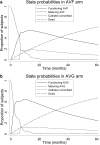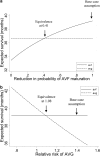Choice of vascular access among incident hemodialysis patients: a decision and cost-utility analysis
- PMID: 20876675
- PMCID: PMC2994091
- DOI: 10.2215/CJN.03210410
Choice of vascular access among incident hemodialysis patients: a decision and cost-utility analysis
Abstract
Background and objectives: Arteriovenous fistulas (AVFs) are widely accepted as the preferred hemodialysis vascular access type. However, supporting data have failed to consider morbidity and mortality incurred during failed creation attempts and may therefore overstate potential advantages. This study compares survival, quality-adjusted survival, and costs among incident hemodialysis patients after attempted placement of AVFs or arteriovenous grafts (AVGs).
Design, setting, participants, & measurements: Analogous Markov models were created, one each for AVF and AVG. Patients entered consideration at the time of first access creation, contemporaneous with dialysis initiation. Subsequent outcomes were determined probabilistically; transition probabilities, utilities, and costs were gathered from published sources. To ensure comparability between AVFs and AVGs, the timing and likelihood of access maturation were measured in a contemporary cohort of incident hemodialysis patients.
Results: Mean (SD) overall survival was 39.2 (0.8) and 36.7 (1.0) months for AVFs and AVGs, respectively: difference (95% confidence interval [CI]) 2.6 (1.8, 3.3) months. Quality-adjusted survival was 36.1 (0.8) and 32.5 (0.9) quality-adjusted life months (QALMs) for AVFs and AVGs, respectively: difference (95% CI) 3.6 (2.8, 4.3) QALMs. The incremental cost-effectiveness ratio (95% CI) for AVFs relative to AVGs was $446 (-6023, 6994) per quality-adjusted life year saved.
Conclusions: AVFs are associated with greater overall and quality-adjusted survival than AVGs. Observed differences were much less pronounced than might be expected from existing literature, suggesting that prospective identification of patients at high risk for AVF maturational failure might enable improvements in health outcomes via individualization of access planning.
Figures





Similar articles
-
Cost-effectiveness of vascular access for haemodialysis: arteriovenous fistulas versus arteriovenous grafts.Eur J Vasc Endovasc Surg. 2013 Jan;45(1):84-92. doi: 10.1016/j.ejvs.2012.10.012. Epub 2012 Nov 13. Eur J Vasc Endovasc Surg. 2013. PMID: 23153926
-
Vascular Access for Hemodialysis Patients: New Data Should Guide Decision Making.Clin J Am Soc Nephrol. 2019 Jun 7;14(6):954-961. doi: 10.2215/CJN.00490119. Epub 2019 Apr 11. Clin J Am Soc Nephrol. 2019. PMID: 30975657 Free PMC article. Review.
-
Medicare Costs Associated With Arteriovenous Fistulas Among US Hemodialysis Patients.Am J Kidney Dis. 2018 Jul;72(1):10-18. doi: 10.1053/j.ajkd.2018.01.034. Epub 2018 Mar 28. Am J Kidney Dis. 2018. PMID: 29602630
-
International Differences in the Location and Use of Arteriovenous Accesses Created for Hemodialysis: Results From the Dialysis Outcomes and Practice Patterns Study (DOPPS).Am J Kidney Dis. 2018 Apr;71(4):469-478. doi: 10.1053/j.ajkd.2017.09.012. Epub 2017 Dec 1. Am J Kidney Dis. 2018. PMID: 29198387
-
Sonography of Arteriovenous Fistulas and Grafts.Semin Dial. 2017 Jul;30(4):309-318. doi: 10.1111/sdi.12599. Epub 2017 Apr 10. Semin Dial. 2017. PMID: 28393400 Review.
Cited by
-
Elderly patients with CKD--dilemmas in dialysis therapy and vascular access.Nat Rev Nephrol. 2014 Feb;10(2):116-22. doi: 10.1038/nrneph.2013.256. Epub 2013 Dec 3. Nat Rev Nephrol. 2014. PMID: 24296629 Review.
-
Vascular access cannulation and haemostasis: a national observational study of French practices.Clin Kidney J. 2020 Oct 2;14(4):1261-1268. doi: 10.1093/ckj/sfaa098. eCollection 2021 Apr. Clin Kidney J. 2020. PMID: 33841870 Free PMC article.
-
Outcomes of Elderly Patients after Predialysis Vascular Access Creation.J Am Soc Nephrol. 2015 Dec;26(12):3133-40. doi: 10.1681/ASN.2014090938. Epub 2015 Apr 8. J Am Soc Nephrol. 2015. PMID: 25855782 Free PMC article.
-
Supply and Distribution of Vascular Access Physicians in the United States: A Cross-Sectional Study.Kidney360. 2020 Aug;1(8):763-771. doi: 10.34067/kid.0002722020. Epub 2020 Aug 27. Kidney360. 2020. PMID: 34355198 Free PMC article.
-
Center-Effect of Incident Hemodialysis Vascular Access Use: Analysis of a Bi-national Registry.Kidney360. 2021 Feb 9;2(4):674-683. doi: 10.34067/KID.0005742020. eCollection 2021 Apr 29. Kidney360. 2021. PMID: 35373038 Free PMC article.
References
-
- National Kidney Foundation Kidney Disease Outcomes Quality Initiative Guidelines: Clinical Practice Guidelines and Clinical Practice Recommendations: Bethesda, MD, National Kidney Foundation, 2006
-
- Tordoir J, Canaud B, Haage P, Konner K, Basci A, Fouque D, Kooman J, Martin-Malo A, Pedrini L, Pizzarelli F, Tattersall T, Vennegoor M, Wanner C, ter Wee P, Vanholder R: EBPG on vascular access. Nephrol Dial Transplant 22[Suppl 2]: ii88–ii117, 2007 - PubMed
-
- Bradbury BD, Fissell RB, Albert JM, Anthony MS, Critchlow CW, Pisoni RL, Port FK, Gillespie BW: Predictors of early mortality among incident U.S. hemodialysis patients in the Dialysis Outcomes and Practice Patterns Study (DOPPS). Clin J Am Soc Nephrol 2: 89–99, 2007 - PubMed
-
- Ishani A, Collins AJ, Herzog CA, Foley RN: Septicemia, access and cardiovascular disease in dialysis patients: The USRDS Wave 2 study. Kidney Int 68: 311–318, 2005 - PubMed
-
- Astor BC, Eustace JA, Powe NR, Klag MJ, Fink NE, Coresh J: Type of vascular access and survival among incident hemodialysis patients: The Choices for Healthy Outcomes in Caring for ESRD (CHOICE) Study. J Am Soc Nephrol 16: 1449–1455, 2005 - PubMed
Publication types
MeSH terms
Grants and funding
LinkOut - more resources
Full Text Sources
Medical

